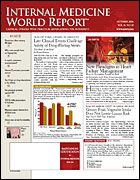Publication
Article
Internal Medicine World Report
Highly Drug-Resistant TB Often Fatal in Patients with HIV
Author(s):
From the International AIDS Conference
TORONTO—Physicians caring for HIV-positive patients can learn a chilling lesson about the dangers of extremely drug-resistant tuberculosis (TB), and the need for continued vigilance for prevention and treatment, from an outbreak among South African AIDS patients described at the XVI International AIDS Conference.
Multidrug-resistant TB is defined as resistance to isoniazid and rifampin (Rifadin), whereas extremely drug- resistant disease is resistance to these 2 agents, as well as to at least 3 of the 6 main classes of second-line drugs.
Investigators obtained sputum samples from 1539 HIV-positive patients in a rural district hospital in KwaZulu-Natal who were suspected of having active TB. Approximately one third (544) had Mycobacterium tuberculosis infection, including 221 with multi-drug-resistant disease and 53 with extremely drug-resistant disease. Fully 87% of the extremely drug-resistant TB patients had genetically similar TB strains, suggesting infection from 1 or only a few external point sources, a common pattern in outbreaks.
Among the patients with extremely drug-resistant TB, 52 (98%) died. Median survival from the time of sputum collection was only 16 days.
Lead investigator Neel Gandhi, MD, assistant professor of medicine, Albert Einstein College of Medicine, New York City, stressed the need for a steady flow of resources for TB treatment and prevention programs around the world, as well as for the development of new drugs.
“Of the TB drugs that we use routinely now, the last one that was invented was rifampin, and that was 3 to 4 decades ago,” he said. “And the fact that we have TB bacteria out there that are resistant to not only all of the first-line drugs, but also to many if not all of the second-line drugs, makes the development of new agents particularly urgent.”
Commenting on the South African trial in BMJ (2006; 333: 559-560), Stephen D. Lawn, MD, Institute of Infectious Disease and Molecular Medicine, University of Cape Town, South Africa, wrote, “The emergence of extensively drug-resistant tuberculosis should come as no surprise—it was entirely predictable in the context of poor control practices.”
There were several outbreaks of multidrug-resistant TB in the United States in the early 1990s, and a recent study in Morbidity and Mortality Weekly Report (2006; 55:301-309) documented a 4.1% rate of extremely drug-resistant disease among Americans with multidrug-resistant TB.
Calling extremely drug-resistant TB “a serious and emerging public health threat,” the study authors also noted that from 1993 to 2002, this type of patients were 64% more likely to die during treatment than patients with multidrug-resistant TB. HIV-positive patients are particularly likely to harbor such infections, as they are at an almost 10-fold greater risk of becoming sick from TB, and hence needing drug treatment, than patients without HIV.
“An outbreak of extensively drug-resistant TB could occur again in North America, and it’s important that we prevent that from happening,” affirmed Richard Chaisson, MD, professor of infectious diseases and founding director, Center for Tuberculosis Research, Johns Hopkins University School of Medicine, Baltimore. “We can do that by ensuring that patients with regular TB are properly managed, that people with HIV/AIDS get treatment to prevent TB, and that those with drug-resistant TB are appropriately managed and treated, preventing further spread of the infection.”





